Open source and free shadcn templates using Prisma
22 templates • 19 contributors • Open source & free
22
Templates
19
Authors
Available Templates (22)

Next Prisma Tailwind Ecommerce
Next Prisma Tailwind Ecommerce is an open-source, full-stack e-commerce platform built with TypeScript, Next.js 14 App Router with React Server Components, Prisma ORM, Tailwind CSS, Radix UI, shadcn/ui, and Zod validation, providing both a customer-facing storefront and a comprehensive admin panel for complete store management. This enterprise-grade solution features custom dynamic sitemap generation for SEO, admin dashboard for managing products, orders, and payments, file uploads with next-cloudinary integration, JWT authentication with httpOnly cookies for security, storefront with integrated blog powered by MDX, email verification and invoice generation, metadata handling for SEO optimization, and internationalization support for global markets. The monorepo architecture separates the admin and storefront applications, allowing independent scaling and deployment to Vercel, Netlify, or Docker environments. Perfect for businesses launching online stores with full control over the stack, developers building custom e-commerce solutions for clients, startups requiring rapid deployment without merchant lock-in, or any project where combining content marketing (blog) with product sales creates competitive advantages. The separation of admin and storefront concerns enables teams to work independently on customer experience and operational tools, while the MDX-powered blog system allows non-technical team members to create SEO-optimized content that drives organic traffic and customer engagement.
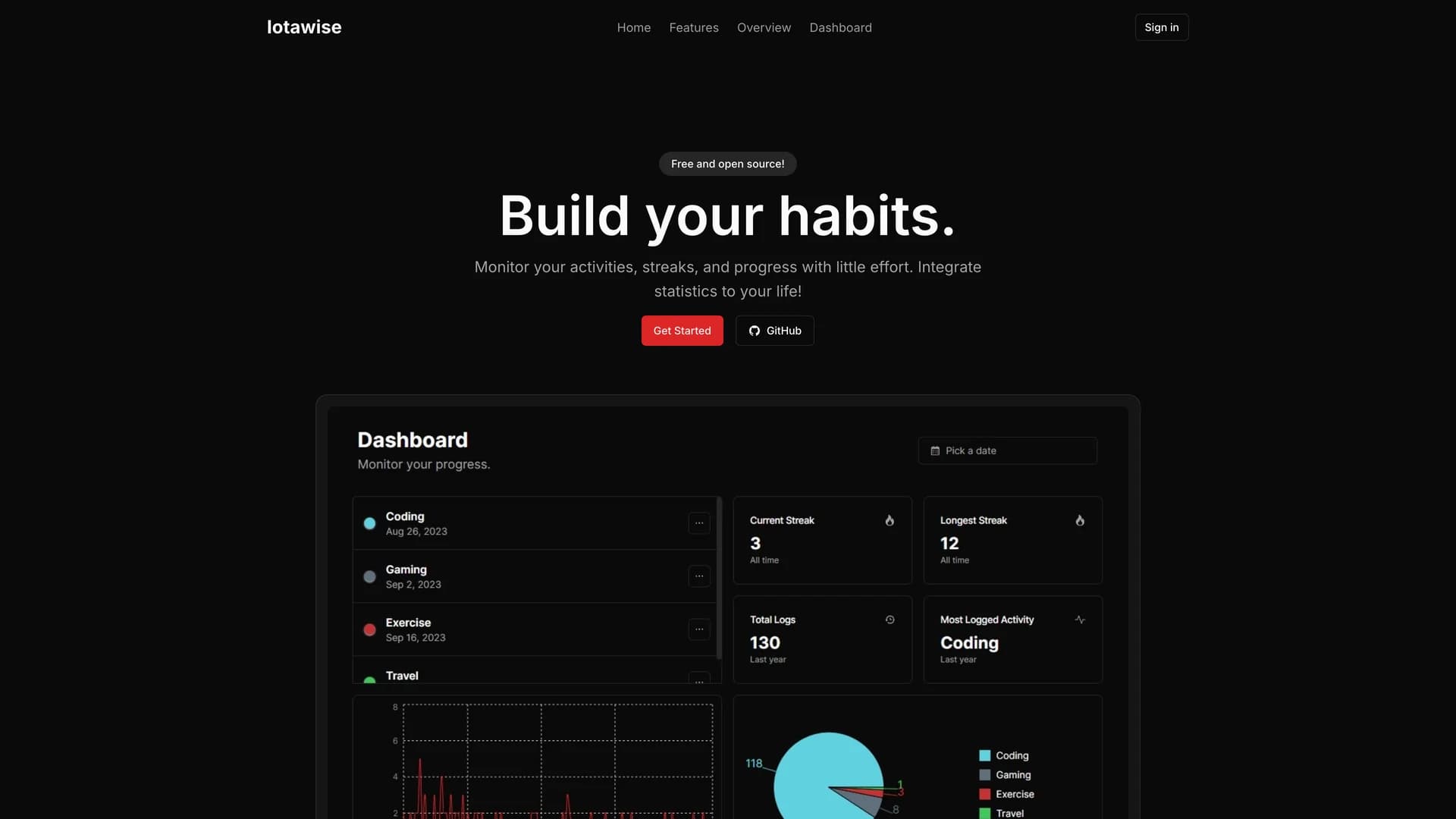
Iotawise
Iotawise is an open-source habit tracking application built with Next.js App Directory, TypeScript, Tailwind CSS, shadcn/ui, NextAuth.js, Prisma ORM, Zod validations, and Neon PostgreSQL, designed to help users monitor and improve daily habits and activities with minimal complexity and maximum insight. This streamlined platform provides a user-friendly interface for daily habit logging, activity streak monitoring to maintain motivation, dashboard analytics visualizing progress and patterns, Google Authentication for quick onboarding, planned web push notifications for habit reminders, and cross-platform PWA support for native-like experiences on mobile and desktop. The application emphasizes simplicity and ease of use, removing barriers that cause users to abandon more complex habit-tracking systems while still providing enough analytics to maintain motivation and identify improvement opportunities. Perfect for individuals building positive routines and breaking negative habits, productivity enthusiasts tracking multiple areas of life improvement, health and fitness goals requiring daily consistency, or anyone seeking behavior change where streak visualization and progress tracking provide the psychological reinforcement needed for long-term habit formation. The combination of NextAuth.js for authentication, Prisma for type-safe database access, and Zod for runtime validation creates a robust, maintainable codebase, while the planned PWA support will enable offline habit logging and push notifications that keep users engaged with their goals throughout the day.
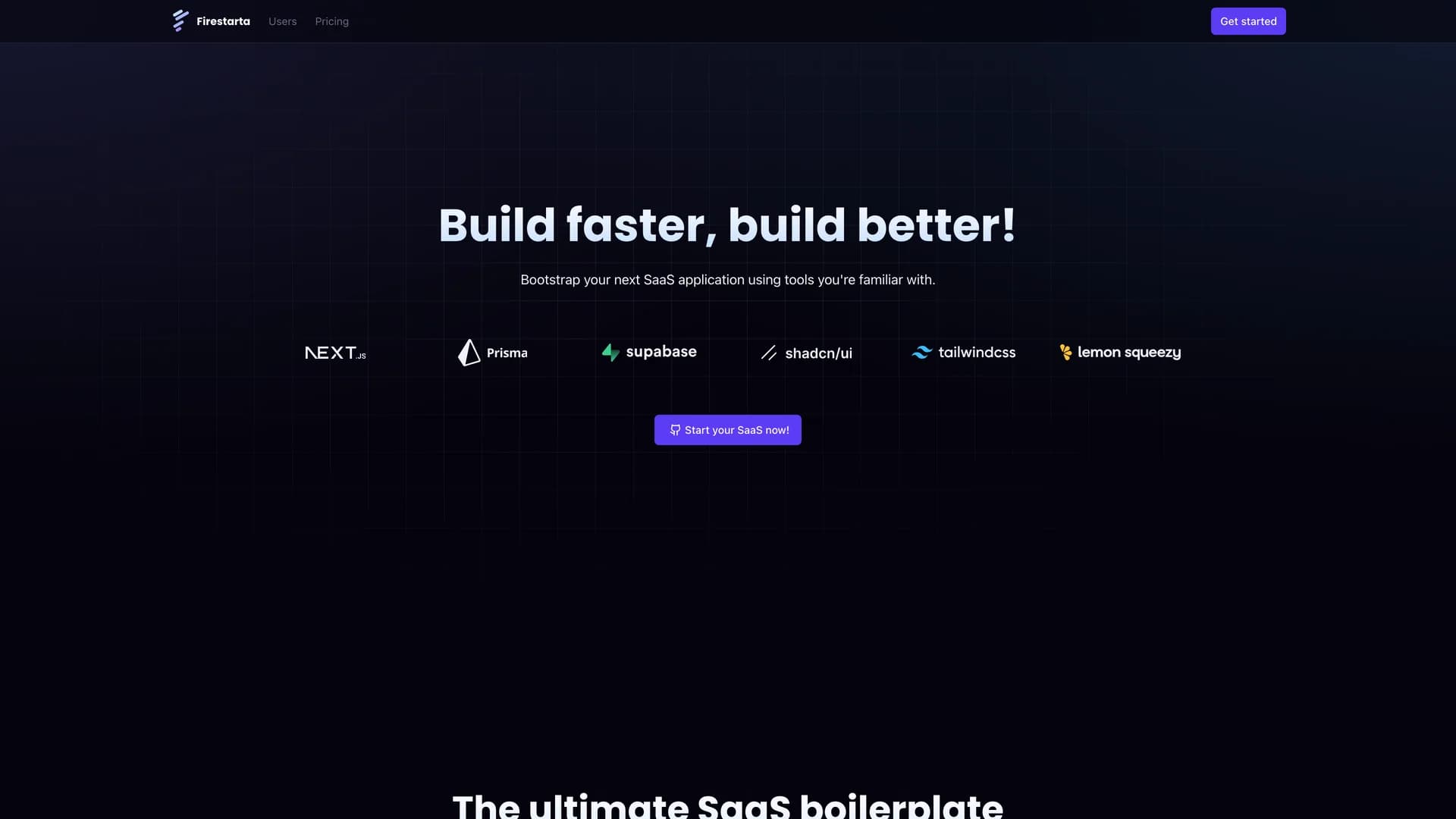
Firestarta
Firestarta is a comprehensive Next.js SaaS boilerplate built with TypeScript, NextAuth for authentication, Prisma ORM, Supabase Postgres, Lemon Squeezy for subscription management, Sass, shadcn/ui, and Lucide icons, designed to provide a robust starting point for web applications requiring user authentication, subscription payments, and modern development practices. This production-ready template features App directory structure with Route Groups, Intercepting and Parallel Routes, server-side and client-side rendering for optimal performance, comprehensive user authentication flows, integrated subscription management with Lemon Squeezy, responsive design across all devices, internationalization support for global markets, and custom components following best practices. Built with modern web development standards and a flexible, extensible architecture, Firestarta eliminates weeks of initial setup work that every SaaS application requires before addressing unique product features. Perfect for developers building subscription-based products, entrepreneurs launching SaaS businesses with limited technical teams, agencies delivering custom SaaS solutions for clients, or any project where rapid development without sacrificing code quality and scalability determines market success. The integration of NextAuth, Prisma, and Supabase provides a complete authentication and data management stack, while Lemon Squeezy handles the complexity of subscription billing, tax compliance, and payment processing, enabling founders to focus on product differentiation and customer acquisition rather than infrastructure and payment integration challenges.
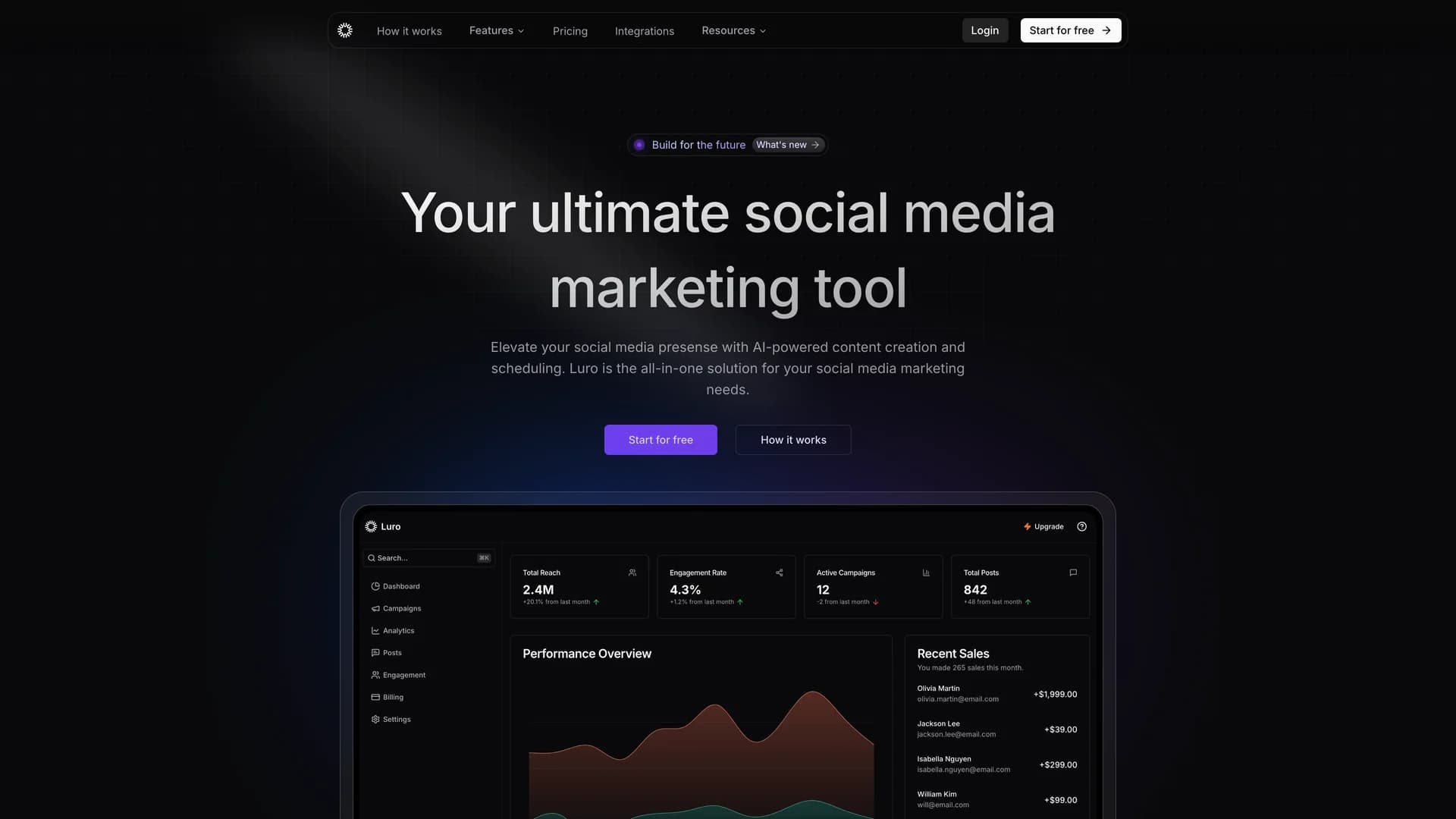
Luro AI
Luro AI is a stunning, modern social media marketing platform landing page that showcases next-generation SaaS design with AI-powered features for streamlining social media management. Built with Next.js, TypeScript, Tailwind CSS, and a combination of premium UI libraries including shadcn/ui, Magic UI, and Aceternity UI, this project demonstrates how to create visually impressive marketing websites with smooth animations, interactive components, and professional design patterns. The platform features real-time social media performance tracking across multiple channels, engagement rate calculations and analytics visualization using Recharts, audience growth insights with trend analysis, custom report generation for stakeholder presentations, ROI tracking and analysis for marketing campaigns, and comprehensive data visualization capabilities powered by React charts. The tech stack includes Prisma ORM with MongoDB for flexible data modeling, Clerk authentication for user management, React Hook Form for validated input handling, and Framer Motion for fluid animations and micro-interactions that enhance user experience. The design emphasizes clean layouts with strategic use of whitespace, glassmorphism effects and modern gradient backgrounds, responsive components that adapt beautifully to all screen sizes, and accessibility-first patterns ensuring inclusive user experiences. This project is perfect for developers building SaaS marketing pages that need to impress investors and customers, learning how to combine multiple UI libraries cohesively, studying modern design trends in AI and analytics platforms, creating portfolio pieces that demonstrate frontend expertise, and understanding how to implement complex data visualizations in React. Luro AI serves as an excellent reference for contemporary SaaS landing page design, showing how to balance aesthetics with functionality.
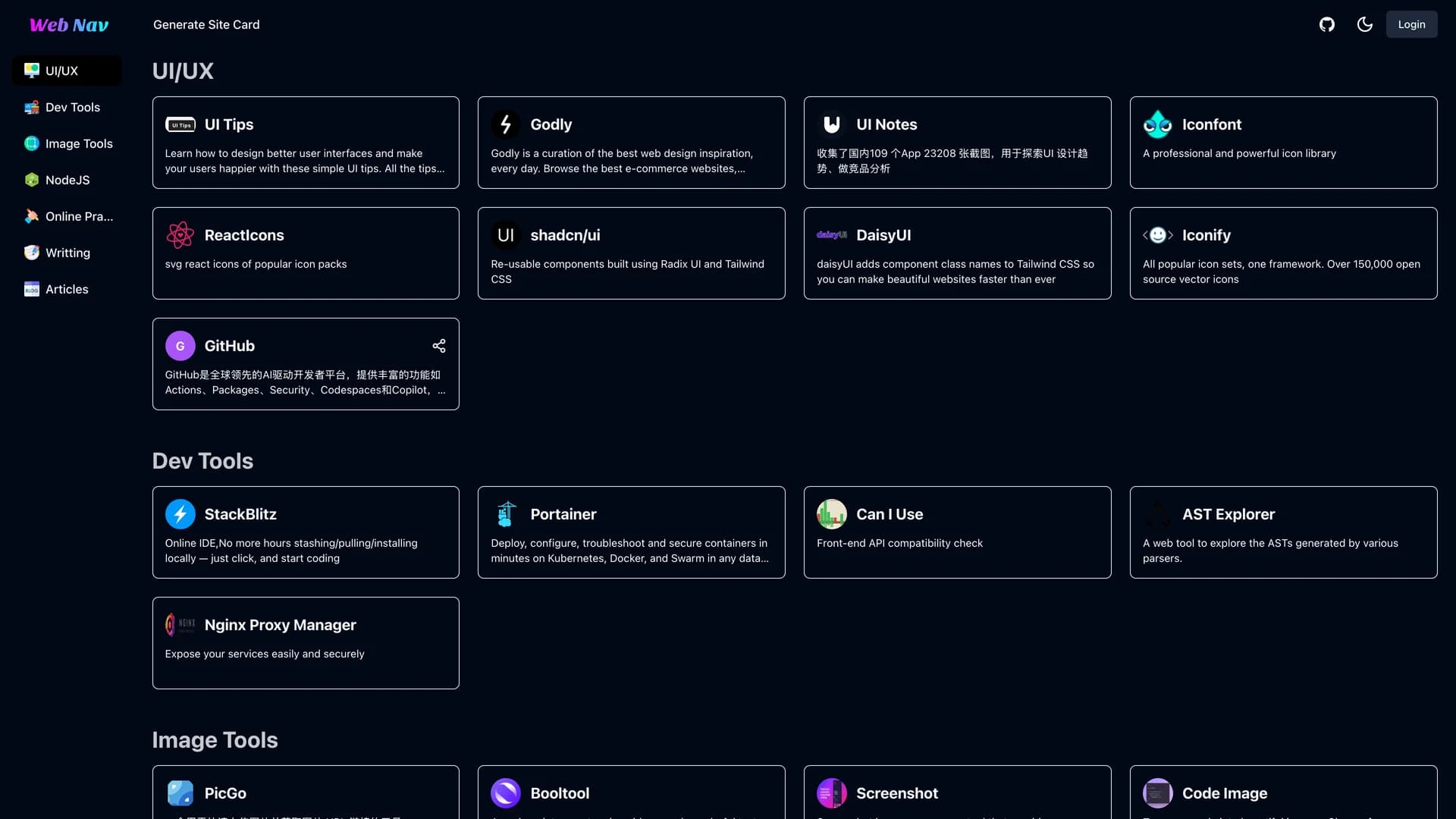
Frontend Nav
Frontend Nav is a curated navigation website designed to collect, organize, and showcase high-quality frontend development resources from both domestic and international sources, making it easy for developers to discover essential tools, libraries, tutorials, and communities. Built with Next.js 13, TypeScript, Radix UI components, Tailwind CSS, NextAuth.js for authentication, Prisma ORM with MySQL on PlanetScale, and Puppeteer for automated screenshot generation, this project demonstrates modern web application development while solving a real problem: the overwhelming fragmentation of frontend resources across the internet. The platform features automated webpage information capture using Puppeteer to extract metadata, titles, and descriptions, shareable website cards with screenshots for visual recognition, user authentication allowing developers to save their personal collections, organized categorization of resources by topic, framework, or use case, dark mode support for comfortable browsing in different environments, and one-click deployment to Vercel for easy hosting. Inspired by the Taxonomy project, Frontend Nav emphasizes clean data presentation, intuitive navigation, and rapid resource discovery. The application uses MySQL hosted on PlanetScale for scalable database management, Prisma for type-safe database queries, and NextAuth.js for flexible authentication supporting multiple providers. This project is valuable for developers building resource directories or curated link collections, learning modern full-stack Next.js development patterns, studying how to implement web scraping with Puppeteer for metadata extraction, creating personal knowledge bases or bookmark managers, and understanding how to build CRUD applications with authentication and database integration. Frontend Nav serves both as a practical tool for organizing frontend resources and as an educational codebase demonstrating production-ready Next.js architecture.
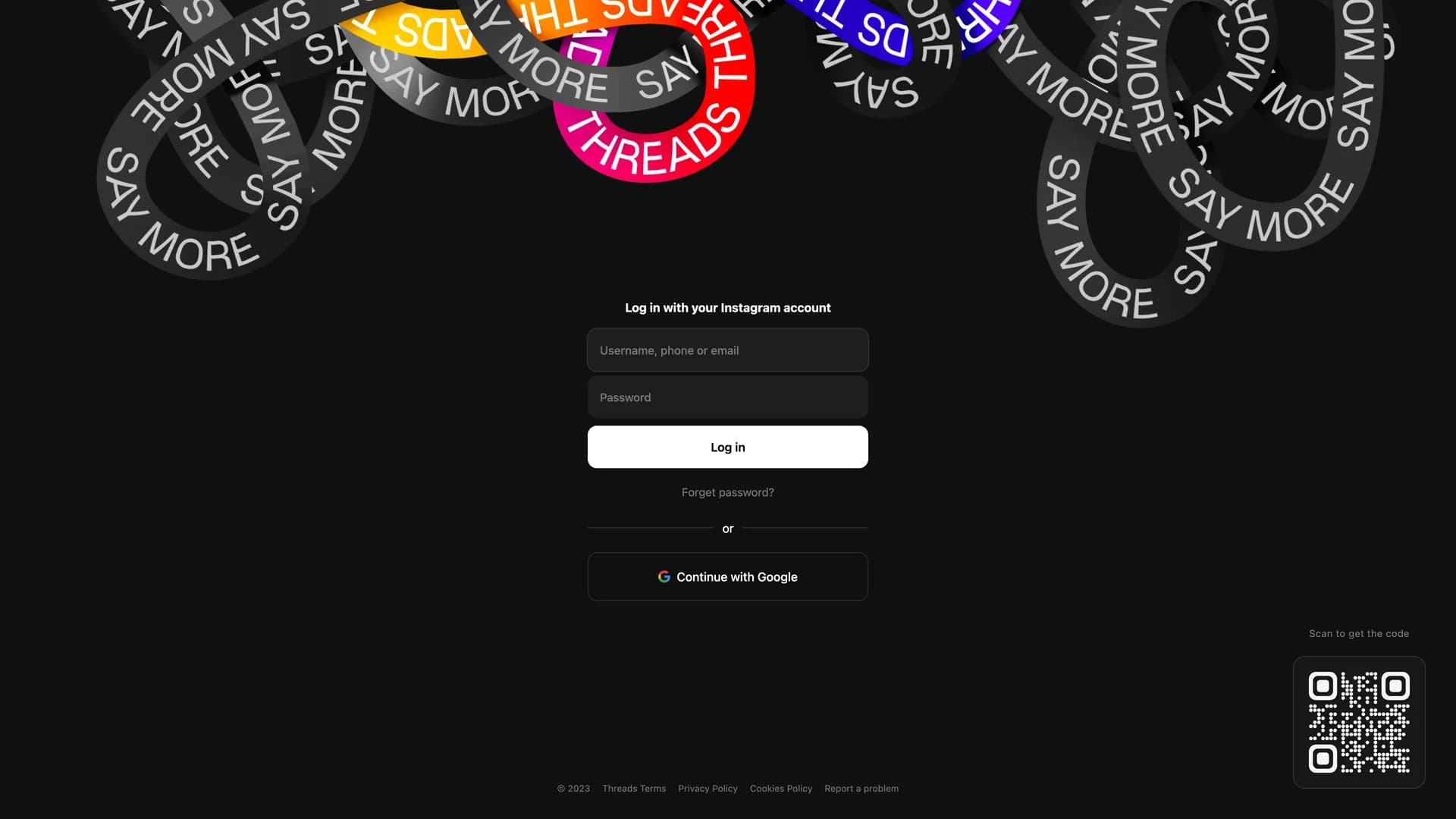
Threads Clone
The Threads Clone is a comprehensive, full-featured recreation of Meta's Threads social media platform built with the T3 stack, showcasing modern web development practices for building complex, production-ready social applications. Created with Next.js 14, TypeScript, tRPC for end-to-end type-safe APIs, Tailwind CSS, shadcn/ui components, Prisma ORM with Neon PostgreSQL, and Clerk authentication, this project demonstrates how to architect scalable social networking features with contemporary tools. The application includes complete user authentication and profile management via Clerk, file upload capabilities for images and media, threaded conversations with nested replies and interactions, text and image content filtering for moderation, custom notification systems for user engagement, recursive thread rendering for deep conversation trees, real-time updates reflecting new posts and interactions, Zod validation ensuring data integrity throughout the stack, and advanced Prisma ORM patterns for complex relational queries. Built with create-t3-app, the project follows T3 stack principles emphasizing type safety, developer experience, and rapid iteration. The implementation showcases tRPC's ability to provide fully typed API routes without code generation, Prisma's sophisticated ORM features for managing complex database relationships, Clerk's comprehensive auth solution including social logins and user metadata, and Next.js 14's app router for optimal performance and SEO. This clone is invaluable for developers learning to build social media platforms from scratch, studying how to implement threaded conversations and notifications, understanding T3 stack architecture and patterns, creating portfolio pieces demonstrating full-stack expertise, and exploring how to scale social features with modern tooling. The codebase serves as both a functional social platform and an educational resource for contemporary web development.
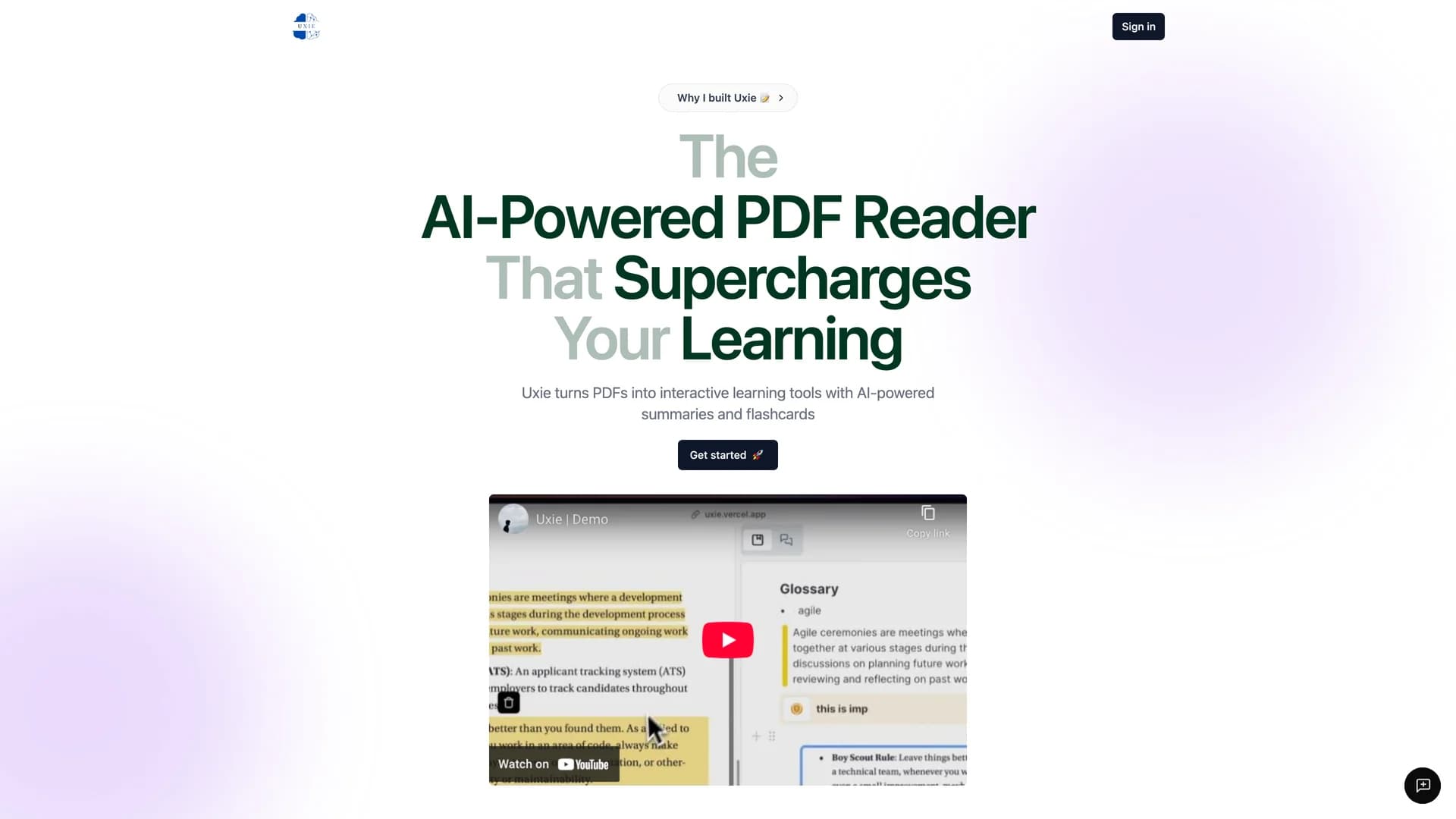
Uxie
Uxie is an intelligent PDF reader application that started as a first-place hackathon project and evolved into a comprehensive learning platform combining PDF annotation, note-taking, real-time collaboration, and AI-powered features including chat, flashcard generation with AI feedback, text-to-speech, and OCR capabilities. Built with Next.js, TypeScript, Tailwind CSS, shadcn/ui components, tRPC for type-safe APIs, Prisma ORM for database management, Supabase for backend services, Vercel AI SDK and Langchain for AI features, Pinecone for vector embeddings, Next Auth for authentication, and Liveblocks for real-time collaboration, this full-stack application transforms static PDFs into interactive learning experiences. The platform features comprehensive PDF annotation tools with highlighting, underlining, and margin notes, intelligent note-taking with custom editor blocks and AI-powered text autocompletion, AI chat functionality that answers questions about document content using RAG (Retrieval Augmented Generation), automatic flashcard generation from document content with LLM-generated feedback on answers, sentence-by-sentence text-to-speech with visual highlighting (English only), OCR support for extracting text from scanned documents and images, real-time collaborative editing powered by Liveblocks allowing multiple users to annotate simultaneously, and vector embedding storage in Pinecone for semantic search and AI context. The AI integration uses the Vercel AI SDK and Langchain to provide contextual understanding of PDFs, enabling students to ask questions and receive answers grounded in the actual document content. This application is invaluable for students who want to enhance their study sessions with AI-powered learning tools, researchers annotating academic papers and collaborating on document analysis, professionals reviewing contracts or reports with team members, educators creating interactive reading materials with embedded questions and flashcards, and anyone who learns better through active engagement rather than passive reading. Uxie demonstrates how to build AI-enhanced document viewers, implement real-time collaboration in React applications, integrate vector databases for semantic search, create custom text editors with AI features, and design engaging learning experiences through technology.
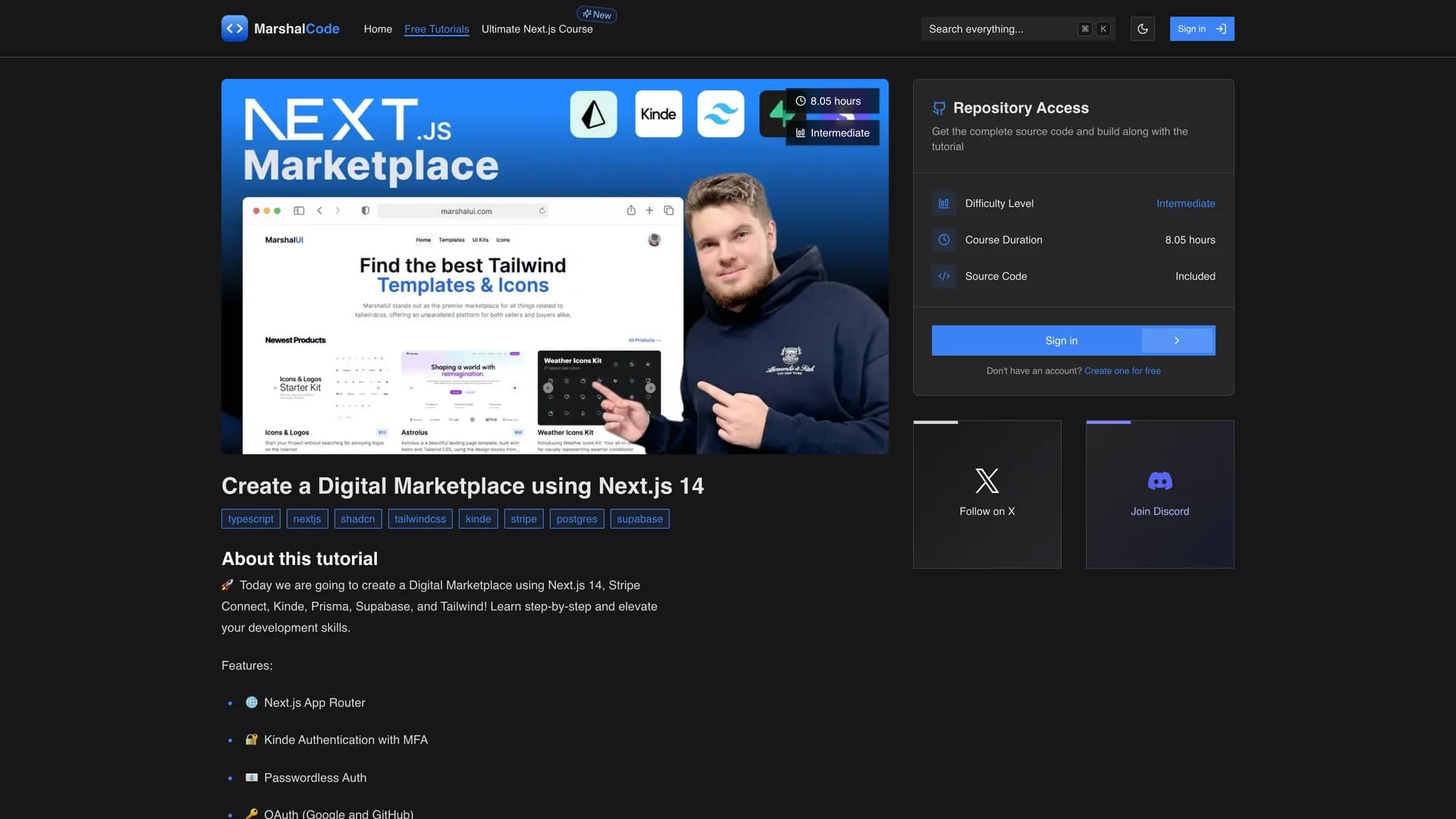
Marshal UI YouTube
Marshal UI is a comprehensive digital marketplace application built with Next.js 14, demonstrating how to create production-ready platforms where creators can sell digital products with built-in payment processing, authentication, and database management. Created by Jan Marshal as a step-by-step tutorial project, this full-featured marketplace integrates Kinde for robust authentication including multi-factor authentication and passwordless login, Stripe Connect for marketplace payments enabling seller payouts and platform fees, Prisma ORM with Supabase PostgreSQL for type-safe database operations, Tailwind CSS and shadcn/ui for modern, accessible components, Zod for server-side validation ensuring data integrity, Resend and React Email for transactional email templates, and deployment on Vercel for global edge performance. The application features comprehensive authentication flows supporting OAuth with Google and GitHub, passwordless magic link login, multi-factor authentication for enhanced security, seller onboarding with Stripe Connect allowing creators to receive payments, product listing and management for digital goods, secure payment processing with Stripe webhooks for real-time updates, email notifications using beautifully designed React Email templates, and server-side validation protecting against malicious inputs. The marketplace architecture showcases how to handle complex payment flows where platform fees are collected while sellers receive payouts, implement webhook handling for asynchronous Stripe events, design database schemas for multi-sided marketplaces, and build type-safe APIs with proper error handling. This project is invaluable for developers learning to build marketplace platforms like Gumroad or Etsy, understanding Stripe Connect integration for multi-vendor payment processing, implementing modern authentication patterns with Kinde, studying full-stack Next.js 14 application architecture, and creating portfolio projects demonstrating e-commerce expertise. The tutorial format helps developers elevate their skills by walking through real-world challenges in marketplace development.
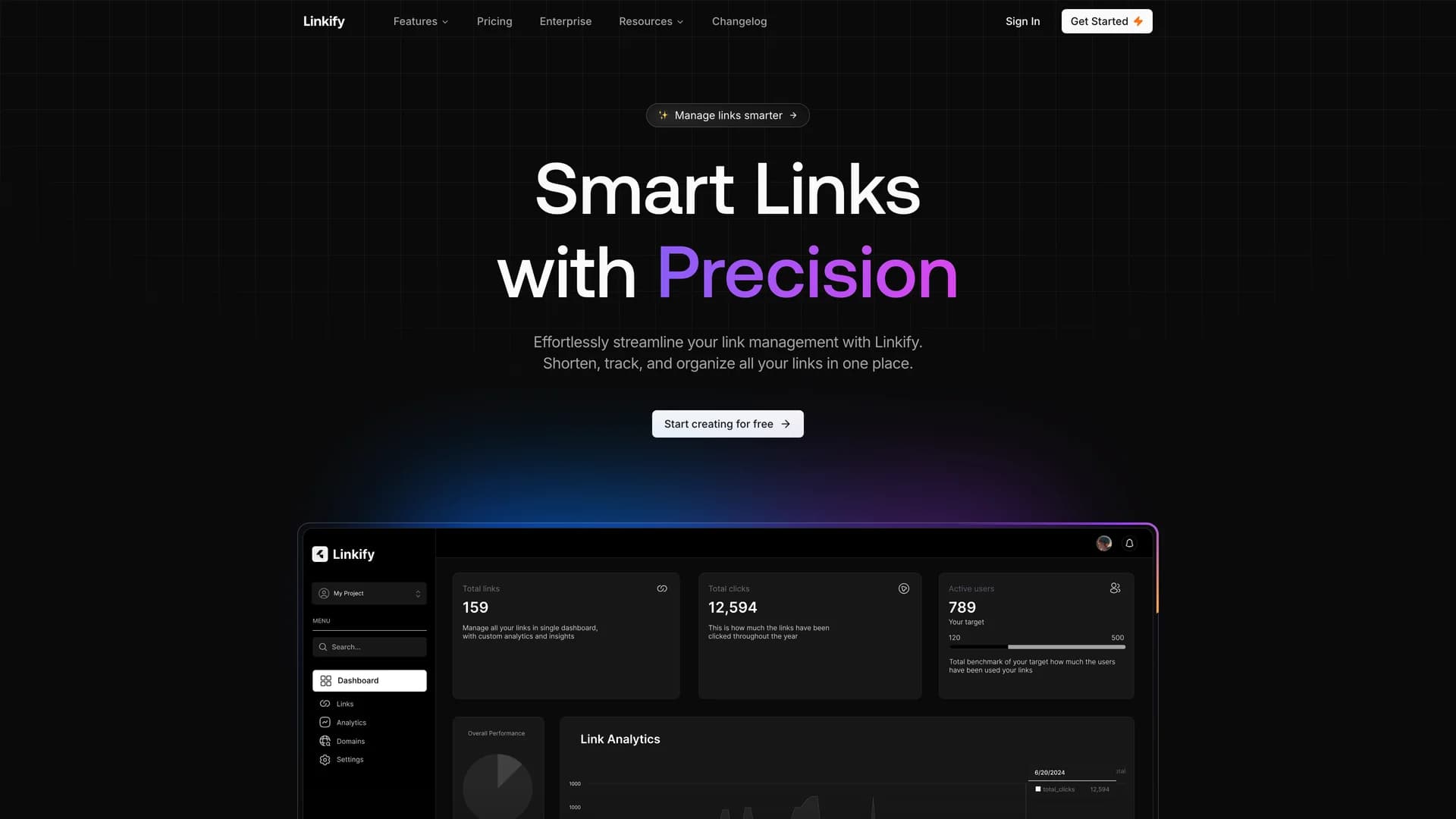
Linkify
Linkify is an innovative link management SaaS platform featuring a modern, conversion-optimized landing page that showcases link shortening, analytics dashboards, customizable branded links, and AI-powered suggestions for link optimization. Built with Next.js, Tailwind CSS, Prisma ORM, MongoDB for flexible data storage, Clerk for authentication, and a combination of premium UI libraries including shadcn/ui, Magic UI, and Aceternity UI, this template demonstrates how to create visually stunning SaaS landing pages that convert visitors into customers. The platform features comprehensive link tracking and analytics showing click-through rates, geographic data, and referral sources, customizable branded short links allowing businesses to maintain brand consistency, AI-powered optimization suggestions improving link performance through intelligent recommendations, responsive landing page design that works beautifully across all devices, modern UI patterns using glassmorphism, gradients, and micro-interactions, clean interface focused on user experience and conversion optimization, and integration patterns for authentication, database, and analytics services. Unlike generic landing page templates that look dated or prioritize aesthetics over conversion, Linkify balances beautiful design with clear value propositions, strong calls-to-action, and social proof elements that drive user acquisition. The multi-library UI approach combines shadcn/ui's accessible components with Magic UI's animated elements and Aceternity UI's distinctive design patterns, creating a unique visual identity that stands out in crowded SaaS markets. This template is invaluable for entrepreneurs launching link management or URL shortening SaaS products, developers building portfolio pieces demonstrating modern SaaS development, teams creating landing pages for beta launches or product announcements, designers learning how to implement complex UI patterns in code, and anyone studying conversion-focused SaaS landing page design. The project includes a YouTube tutorial explaining implementation details, making it accessible for developers at various skill levels. Released under MIT License, Linkify serves as both a functional SaaS landing page template and an educational resource for building modern, conversion-optimized marketing sites.
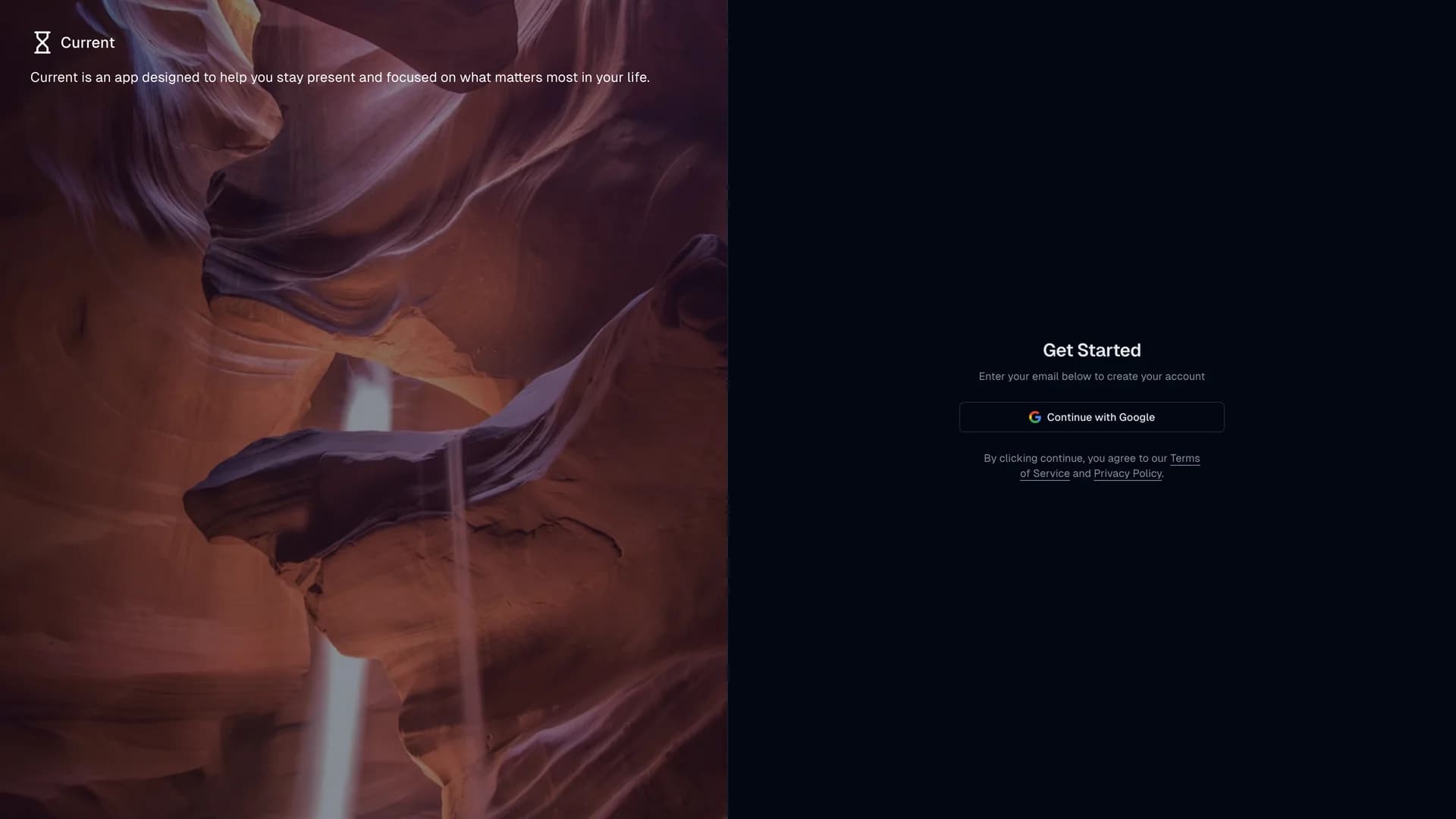
GTD
GTD Task Management App implements the Getting Things Done methodology in a modern web application built with Next.js 13, NextAuth, shadcn/ui, and React Query. Designed for productivity enthusiasts who follow David Allen's GTD system, this app provides digital workflows for capturing, organizing, and executing tasks effectively. The application features inbox capture for quick task entry, project and context-based organization, next actions lists with priority management, and review workflows for weekly planning. Built with TypeScript for type safety, it leverages React Query for efficient data synchronization, NextAuth for secure user authentication, and shadcn/ui components for a clean, distraction-free interface. The app includes task filtering and search, recurring task support, due date management, and progress tracking across projects. Perfect for individuals and teams looking to implement GTD principles digitally with a modern tech stack that ensures reliable performance and seamless user experience.